Rule Zero: Underlings by Libertad!
| 1 | Rules |
| 2 | Races and Templates |
| 3 | Bonus! |
Rules
Original SA postHey everybody, I know it's been a while, but I'm back! I decided today to write up a review of a very short, yet very good third party Pathfinder product which has helped me immensely cut down on stat block preparation and tracking hp and conditions in combat. Without further ado, I present to you...
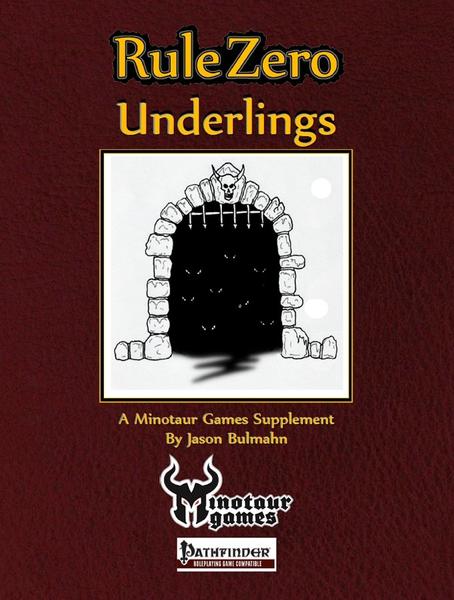
Click the image to be taken to the Drive-Thru RPG page!
3rd Edition D&D and Pathfinder are rules-heavy games, there's no doubt about that. That's not a problem when one knows the rules, but it is a lot more stressful prep work for weekly games; designing proper stat blocks for parties can take over an hour easily, especially at high levels, and the use of minions and over a half-dozen characters on the battlefield can end up a book-keeping nightmare.
It's especially punishing for martial characters who don't have save-or-dies, as even CR 5-6 monsters can have excess of 50 hp don't serve well the role of "mooks who can be downed in one hit" unless everyone at the table's building ubercharger Barbarians. As a lot of high-CR monsters end up turning into walking bags of hit points with Natural Armor, and even low-level Wizards gaining access to a bunch of spells, minimalist minions who can pack a punch but go down easy are very rare in Pathfinder.
Rule Zero: Underlings is the remedy to these problems, and it's served me very well for the months of gaming I've used for it. Fortunately the game mechanics of this product are all OGL, so I'll be showcasing how the rules variants work.
The Humble Underling
An underling is a new type of creature with more simplified rules in combat. They attack, deal damage, take turns, and otherwise act similar to normal characters. However, an underling's stats are primarily determined by their Challenge Rating, which informs their core abilities such as Armor Class, saving throws, damage, etc. Beyond this core CR framework, underlings have a race/monster type to determine their primary roles in combat, while an optional underling template might grant them new abilities or modify one or two traits.
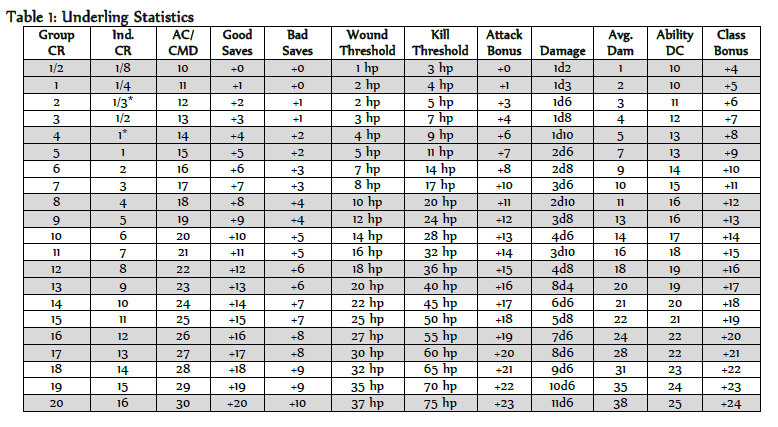
As Underlings are meant to be mooks fought in groups, the
Group CR
measures fighting a group of 4 of them instead of a single creature. Their Inidividual CRs are for when the GM feels like adding in reinforcements, but it is not recommended for using them as individual opponents because they're not meant to be challenging encounters.
So for example, an encounter with three ogres (CR 3 each), the GM might decide to replace one of the ogres with a group of 4 cultists with a Group CR of 3.
Underling stats are extremely streamlined in comparison to base monster rules and class creation for NPCs. Regardless of their natural weapons, equipment, etc, their AC/CMD, Saving Throws, skill bonuses, etc, are determined by their Group CR. Be they vampires, giants, or drow, Underlings with a Group CR of 4 have 14 AC, +6 attack and 1d10 damage with their weapons of choice, and have a Wound and Kill Threshold of 4 and 9 hp respectively. There is some variety, for an Underling's race determines which saving throws are "good" and which are "bad," as well as which skills their "class bonus" entry applies to.
Most of the entries on the table are self-explanatory, but I'll explain a few of them.
AC/CMD:
The AC is the normal value; the book does not mention anything about touch or flat-footed values, so I assume the AC is the same for all three. CMD, or Combat Maneuver Defense, is part of the Combat Maneuver mechanics introduced in Pathfinder which consolidate bull rush/disarm/trip/etc into a single roll (Combat Maneuver Bonus) vs. ones' Combat Maneuver Defense.
Wound/Kill Threshold:
The Wound Threshold represents the minimum amount of damage necessary to wound an Underling of that CR. Wounded underlings function normally, but if they suffer another attack of equal or greater value to their Wound Threshold, they are killed or knocked unconscious (depending on whether non-lethal damage is used). The Kill Threshold represents the minimum damage necessary to kill an Underling; they do not do into the 'dying' condition or can be saved via stabilization, they instantly die once their Kill Threshold is crossed or they're wounded twice.
Damge which deals a value less than an Underling's Wound Threshold is ignored. Conversely, spells and effects which heal can remove the wounded condition from an underling if the damage healed exceeds their Wound Threshold Value.
Attack:
This is the value used for melee and ranged attacks, but it is also the valued used for an Underlings' Combat Maneuver Bonus. Regardless of whether they're swinging a sword, shooting a crossbow, or desiring to disarm an opponent, an Underling uses the same bonus for them all.
However, Underlings are incapable of performing critical hits, and they always provoke an attack of opportunity when they perform a combat maneuver within reach of an enemy. A natural 20 is still an automatic hit, though.
Damage:
Underlings can perform an attack as either a standard or full-round action. Full-round attacks deal the listed damage, but standard attacks deal half damage (rounded down), for both base and Average Damage. Attacks made due to the result of an attack of opportunity deal half damage as well.
Average Damage:
In lieu of rolling damage dice, the GM can instead opt to apply the average damage on the result of a successful attack. Attacks made as part of a standard action or attack of opportunity deal half this value, rounded down.
Ability DC:
Underlings which have special abilities which allow for a saving throw have this as their listed DC.
Skill Bonus:
Basically the Underlings' race determines which skills these bonuses apply to. They have a +0 modifier to skills not listed in their race or template.
Miscellaneous Stuff:
Underlings have an Initiative modifier of +0. They do not have ability scores or class features, and almost none of them gain feats. They use half their Group CR (rounded down) when they must make an ability check, and they are unaffected by ability score damage and drain except for Constitution (which lowers their Wound and Kill Thresholds by a like amount). They cannot die due to bleed damage, only be wounded by it, and any spell or ability which would grant an extra attack or action instead allows them to deal full damage as a standard attack instead.
There's an
Optional Rule for Underling Morale,
hearkening back to the days of Old-School D&D. Basically, Underlings who are wounded when the last non-Underling ally is slain or knocked out in combat attempt to flee the battle as quickly as possible.
Initial Impressions:
I like this universal consolidation of streamlined abilities. Although underlings are overall rather weak, they do have the action economy on their side and if equipped with various debilitating attacks (tanglefoot bags and the like), they can wear down the PCs and soften them up for the main villains. The Wound/Kill Threshold strongly reminds me of Savage Worlds' system for Extras, who would drop immediately when a damaging attack exceeded their Toughness rating. I do think that it's a shame that ability damage/drain is nerfed when used against Underlings, but it's much better than the alternative of book-keeping penalties and the like.
The next post will cover Underling Races and Templates, the latter of which includes things like sneak attack, a limited selection of spell-like abilities, and the like.
Races and Templates
Original SA post
Part Two
Underling Universal Monster Rules
There are 4 new special qualities certain Underlings can gain based on their Race or Template. They include Easily Dispatched (treat Wound/Kill Threshold as 1 CR lower), Improved Damage (treat Damage and Average Damage as 1 CR higher), Wound Regeneration (cannot be Wounded, but exceeding Kill Threshold still dispatches it), and Final Strike (may make one final melee attack as immediate action before death, deals half damage). The first three are rather uninspired, but Final Strike is a pretty cool idea. It does punish melee PCs though, so I might refine it into allowing for ranged attacks (and AoE attacks as well under proper circumstances).
Underling Races
Applying to monster types as well as traditional humans, dwarves, and elves, an Underling's Race handles the rest of the things not covered by the Group CR, such as defensive abilities, weapons and attacks, which skills they apply their Class Bonus to, etc.
There are 47 different types of Underling races, so I'm not going to cover them all. They are very broad, and cover diverse creature types such as demons and popular monsters such as goblins, vampires, and most humanoids. All racial choices have a recommended Group CR range (goblins are CR 1/2 to 1, Minotaurs CR 2-5, and a lot of them are Any), but these are guidelines the GM can ignore rather than restrictions.
Underling speed is highly simplified and tends towards the "default" for certain unlisted traits: Space/Reach is assumed to be 5 feet unless otherwise noted, stat blocks with no Feats section means that the Underling has no feats, Speed is considered 30 feet on land with no special movement unless otherwise noted. Experience points gained are calculated for every 4 of the same type of the same Group CR. So for example, 4 elves with a 3 Group CR give out 800 experience points between the lot of them.
Also, Underlings with ranged weapons always attack with a range increment of 20 feet, and their attacks can never penetrate Damage Reduction. This pretty much makes the specifies of weapon usage purely aesthetic, but it is a great way of further streamlining things. Additionally, some special monster abilities have been converted into spell-like abilities for simplification, and do not gain the benefits of feats unless otherwise noted. Oddly some racial stat blocks have a static DC for special attacks (DC 11 for Harpy's hypnotism, DC 14 for Vampire's Dominate Person), which contradicts the earlier Ability DC being based on CR.
For examples of how the stat blocks can be read, I'm going to show off three sample race blocks:
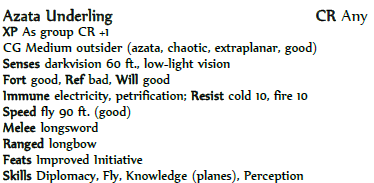
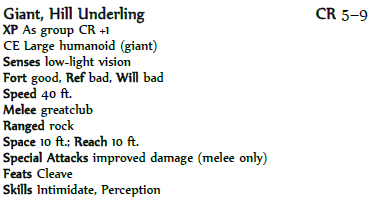
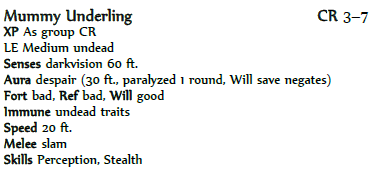
So basically we have a general outline which we can use for building templates for either Azatas or Mummies. Extraneous details go unlisted: the mummy has not feats or ranged entry, therefore it can only attack via melee. but it does have an aura and says which save it's keyed to. Only the Hill Giant is large, so it gets a Space/Reach entry, but it has not defensive abilities or immunities so they go unlisted. Other important details, such as damage, the mummy's Will Save DC, attack and damage bonus, etc are to be determined by the CR.
So let's say we had an Ancient Egypt-themed adventure, and wants to use a bunch of mummies but the PCs are too low-level (5th) to fend off multiple CR 5 mummies at once. So instead he decides to have the adventure's climax be in the burial chamber, where the "mummy lord" (CR 5 mummy) is flanked by 4 loyal guardians (Mummy Underlings with a Group CR of 5), a CR 7 final boss encounter.
Let's stat them up!
Mummy Underling CR 5
XP 1,600
LE Medium undead
AC 15 Wound 5 hp Kill 11 hp
Senses darkvision 60 ft.
Aura despair (30 ft., paralyzed 1 round, Will DC 13 negates)
Fort +2, Ref +2, Will +5
Immune undead traits
Speed 20 ft.
Melee slam +7 (2d6 or avg. damage 7)
Skills Perception +9, Stealth +9
So okay, these mummies are pretty easy push-overs. Their main strength will be their potential paralysis ability, which can let their companions or leader get the jump on PCs frozen in fear. Meanwhile, big-daddy Mummy's sitting nice and comfortable with DR 5, 60 hit points, and a +14 melee attack dealing 1d8+10 damage and mummy rot.
It will be a tough battle, especially in close quarters, but a nice AoE spell such as fireball can dust the mummies, and most melee characters at this level should be able to push past their Kill Threshold with Power Attack and a two-hander.
Underling Templates
These are not true templates but rather simple additions which grant a neat trick and/or some bonus skills. Individual templates add +1 CR to an underling's base stats, so they seem to be meant to be applied only once rather than stacked. But it mentions that templates calculate XP equal to the Group CR +1. So does that mean a base Group CR 6 giant with the berserk template hands out CR 8 XP, or is it part of the package? I don't know, most likely an editing error.
Archer: Underling gains a longbow or crossbow ranged attack, but they gain the poor melee disadvantage (half damage on full action, one-quarter on standard action for melee).
Berserk: XP gained and damage dealt is +1 CR higher than normal, gains Final Strike and Intimidate skill but -2 AC.
Mage/Priest: XP gained is +1 CR higher than normal. Draws a number of spell-like abilities from the cleric or sorcerer/wizard spell list, with a Caster Level equal to Group CR. The spells must have a combined spell level total equal to or less than half the Underling's Group CR. For example, a CR 4 Dwarf Underling with the Mage Template may know how to cast just Scorching Ray, or Magic Missile and Shield, or other such combinations (0 level spells count as 1 level). Spell-like abilities can be cast once per day each, with the exception of cantrips and orisons which can be cast at will. DC equals 10 + spell level.
Mounted: XP gained is +1 CR higher than normal. Speed is 50 feet, charge attack deals full damage even when not full-round action ( even though charge is a full-round action in PF ). Gains Ride skill and mount which does not participate in combat and flees when its rider is slain.
Thief: XP gained is +1 CR higher than normal. Gain Acrobatics and Stealth skills, 1d6 sneak attack plus an additional 1d6 at Group CR 5 and every 4 CR above that (to a maximum of 5d6 at CR 17).
As can be expected, said templates can mimic the features of iconic classes without getting bogged down in details and spell record-keeping. Let's try to use this sample human template:
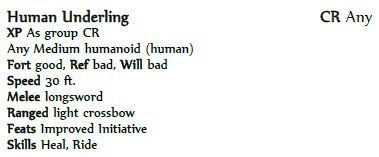
and turn them into the veritable assassins of a secret evil order with the Mage and Thief templates!
Evil Sorcerer-Killer Minions! CR 7 (base 6 +2 Mage and Thief)
XP 4,800?
LE Medium humanoid (human)
AC 17 Wound 8 hp Kill 17 hp
Fort +7, Ref +3, Will +3
Speed 30 ft.
Melee longsword +10 (3d6, 10 avg)
Ranged light crossbow +10 (3d6, 10 avg)
Special Attacks Sneak Attack 2d6
Spell-like Abilities (CL 7th):
at will-detect magic; 1/day-invisibility
Feats Improved Initiative
Skills Acrobatics +11, Heal +11, Knowledge (Arcana) +11, Ride +11, Spellcraft +11, Stealth +11
So these Underlings are squishy, but very sneaky, quick (+4 initiative), and can deal a ton of damage under the right circumstances. Their saves aren't very good, and despite their mobility and arcane knowledge their Perception's shitty. Overall pretty good glass cannons which the major enemies can set up for some nice Sneak Attacks.
And this marks the end of Rule Zero: Underlings.
In conclusion, this is a very useful GMing tool which I use all the time in my games. Creating Underlings is so much faster than typical NPCs, and much easier to keep track of in combat. Their overall weakness is a non-issue, as they are meant to be used in conjunction with normal NPCs and monsters and allow the players to feel bad-ass when their Level 12 Fighter manages to Cleave through four CR 7 Hill Giant Underlings and kill them all in the same round. As the base book is $2.99, and its bonus companion is free, I highly recommend adding it to your collection, whether you play 3.5 or Pathfinder!
Actually, no wait, that's not it. I'm going to review the bonus book, but since this post is getting long enough I figure I'll save it for a Part 3.
Bonus!
Original SA post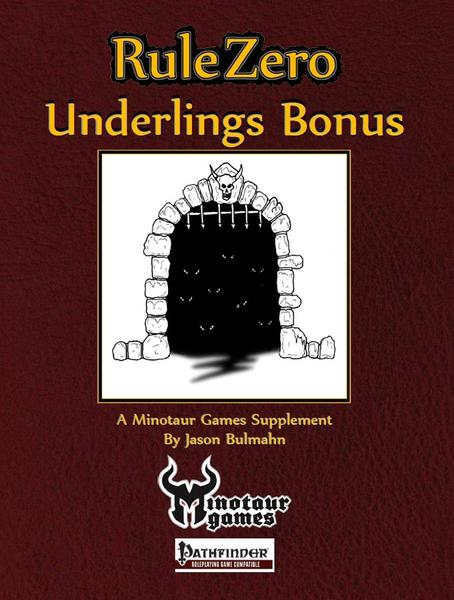
Since the supplement's free and only 4 pages long, I decided to review this one as well. It's a rather bare-bones expansion, with 8 new Underling races (4 of which are Elemental types, 2 of which are Werewolves and Wererats, and 2 of which are Aasimars and Tieflings). The Elemental Underlings are pretty badass, with decent skill selection (Perception plus one or two movement-related ones), whereas the Planetouched and Lycanthropes are typical combatants with some special spell-like ability and some defensive features.
The 2 new Underling Universal Rules included Improved AC and Improved HP, which treat the Underling as being 1 CR higher for the aforementioned values.
But we have new feats and spells, yeah!
quote:
Minion Cleave
You can slice through multiple underlings with ease.
Prerequisite: Power Attack, Str 13.
Benefit: Whenever you kill an underling with a melee attack, either by dealing damage in excess of its Kill Threshold or Wound Threshold (if it was already wounded), you can apply any excess damage to another underling of the same type that is adjacent to you. You can continue to apply damage in this way as long as damage remains, you continue to kill an underling, and there is another underling of the same type adjacent to you.
Stand Aside
You can easily move past lesser foes.
Prerequisite: Dodge.
Benefit: You do not provoke attacks of opportunity from underlings due to movement, as long as that movement does not take you through a square occupied by an underling.
Undead Lord
You can easily create and control undead underlings.
Prerequisite: Spell Focus (necromancy).
Benefit: Whenever you calculate the total number of undead creatures you control, every four undead underlings of the same type count as one creature (using their group CR as the creature’s Hit Dice). Any remaining undead underlings of the same type also count as a single creature. For example, 7 skeleton underlings would count as two creatures. In addition, whenever you create undead using animate dead, you can create underlings, counting four underlings as one creature in terms of the total number of Hit Dice you can create and the cost of casting the spell. You must possess a number of bodies equal to the number of underlings created.
Minion Cleave is a bad-ass yet situational feat, and its usefulness is dependent on how much the GM loves to throw minions at the party. Unless the character's using a reach weapon or has Great Cleave, they probably won't drop many minions unless they're all clustered together. It's good in that the excess damage is carried over automatically without the need for re-rolls, unlike regular Cleave.
Stand Aside...well, underlings don't hit very hard, and since they'll be dealing half damage with AoOs it's not really worth it in my view.
Undead Lord is excellent, in part because of its potential action economy abuse. It is quite thematic, in that every necromancer villain worth their salt is commanding a horde of undead minions to defend their master.
The nine new spells are Summon Underling I-VIII, with SU I a 2nd level Bard/Cleric/Sorcerer/Wizard spell, SU II 3rd level, and so on and so forth. Basically these spells function as Summon Monster, except that they summon 4 Underlings who must be outsiders selected from the following list: angel, archon, azata, demon, devil, or elemental (any). The Group CR of said Underlings is CR 1/2 for SU I, CR 1 for SU II, CR 2 for SU III, and 2 additional points for every spell increment level thereafter to a maximum of CR 12 at SU VIII.
I feel that Summon Underling is a rather weak spell in comparison to Summon Monster counterparts, in part due to the lack of endurance and special abilities, but being able to summon 4 monsters at a time can be useful under the right circumstances. It did not specify whether or not monsters utilizing Underling Templates could be summoned or not. If your GM allows this, then the spell's versatility goes way up in no small part due to the Mage and Priest templates.
And that's it for the Bonus package. I really like the touch of the Summoning spells, Elemental Underlings, and Undead Lord feat. The rest was alright, but at 4 pages for free I'm not complaining.